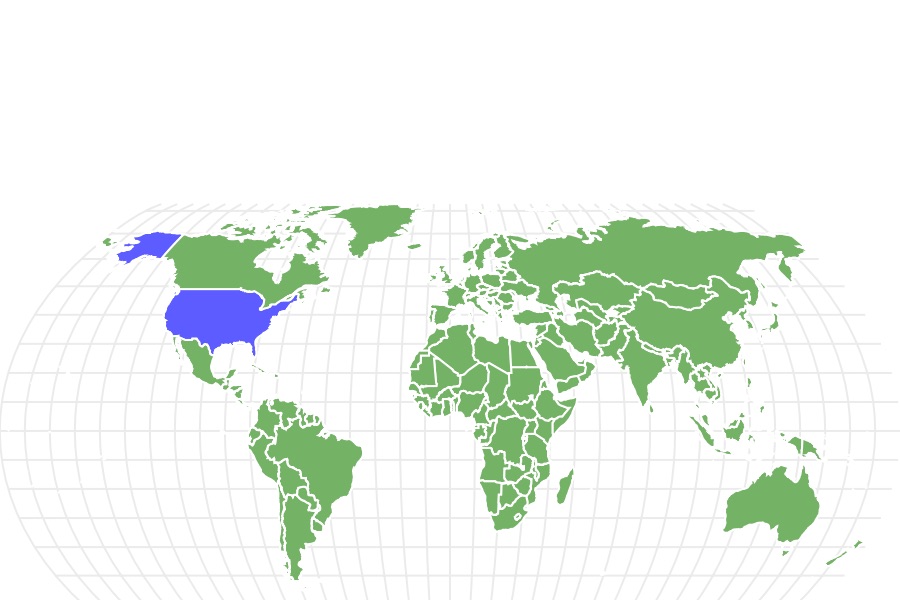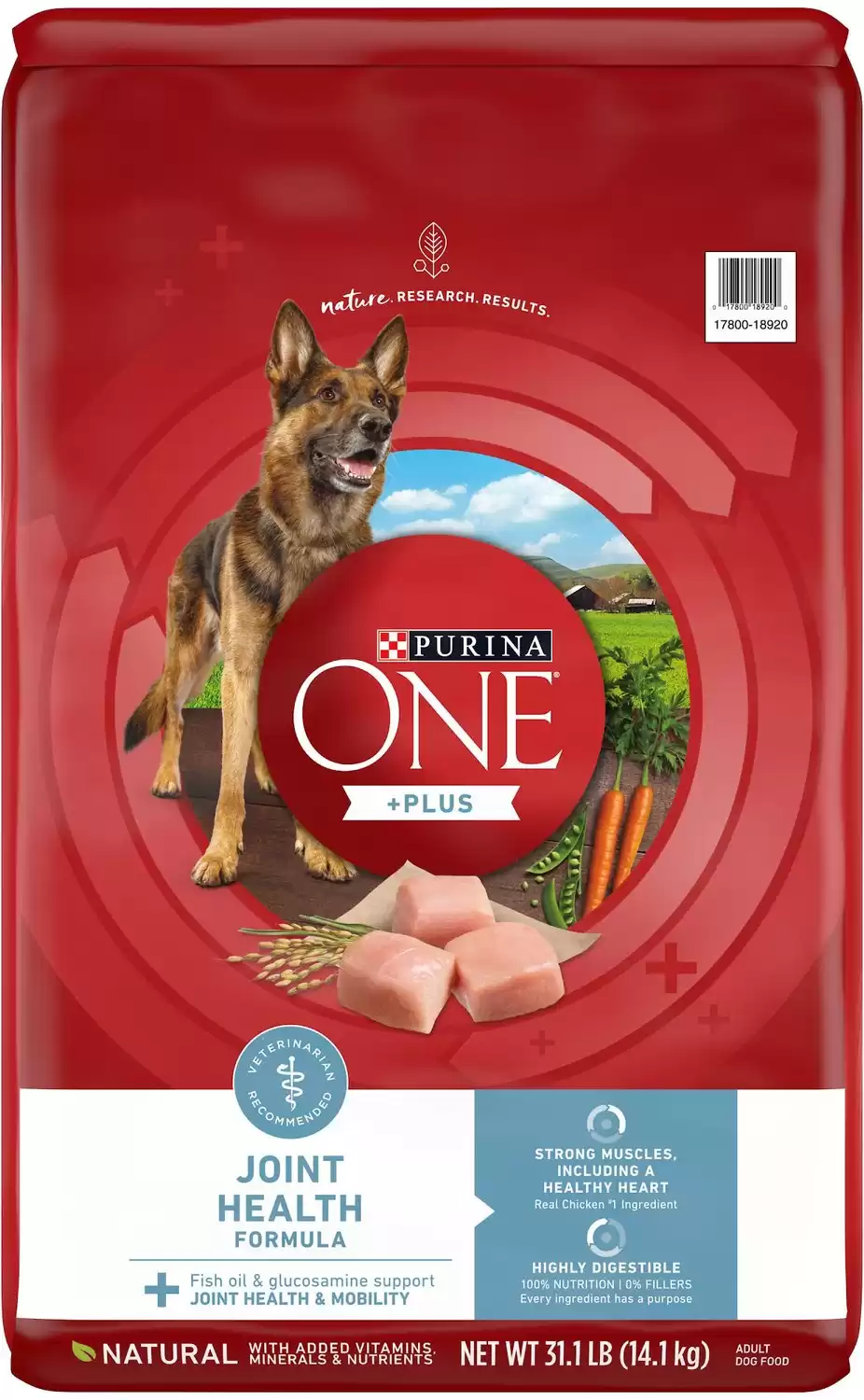Treeing Walker Coonhound
Canis lupus
In addition to raccoons, these dogs can track bears, bobcats, cougars, and deer with ease.
Advertisement
Treeing Walker Coonhound Facts
- Fun Fact
- In addition to raccoons, these dogs can track bears, bobcats, cougars, and deer with ease.
- Temperament
- Loyal and calm
- Diet
- Omnivore
Treeing Walker Coonhound as a Pet:
- General Health
- Energy Level
- Shedability
- Trainability
- Intelligence
- Tendency to Chew
- Size
- Family and kid friendliness
- Yappiness / Barking
- Moderate
- Separation Anxiety
- High
- Preferred Temperature
- Average climate
- Exercise Needs
- High
- Friendly With Other Dogs
- Group
- Dog group
- Hound
- Male weight
- 50-70 lbs
- Female weight
- 50-70 lbs
This post may contain affiliate links to our partners like Chewy, Amazon, and others. Purchasing through these helps us further the A-Z Animals mission to educate about the world's species.
View all of the Treeing Walker Coonhound images!
The Treeing Walker Coonhound lets out a long, yodeling call when on the hunt, and a short repeating bark once they “tree” prey. Whining is normal in anticipation of the hunt.
Loving and confident, Treeing Walker Coonhounds enjoy spending time with humans. Also known as Walkers, they make good house pets but are work-oriented and require something to keep them busy if they are not going out on hunts. Without an outlet for their energy, Walkers can become restless and destructive. Primarily bred to hunt raccoons, the Treeing Walker Coonhound can hunt on its own or as part of a pack. In addition to raccoons, they track bears, bobcats, and cougars with ease. Walkers are also quick and able to hunt deer in states where it is permitted.
See all of our expert product reviews.
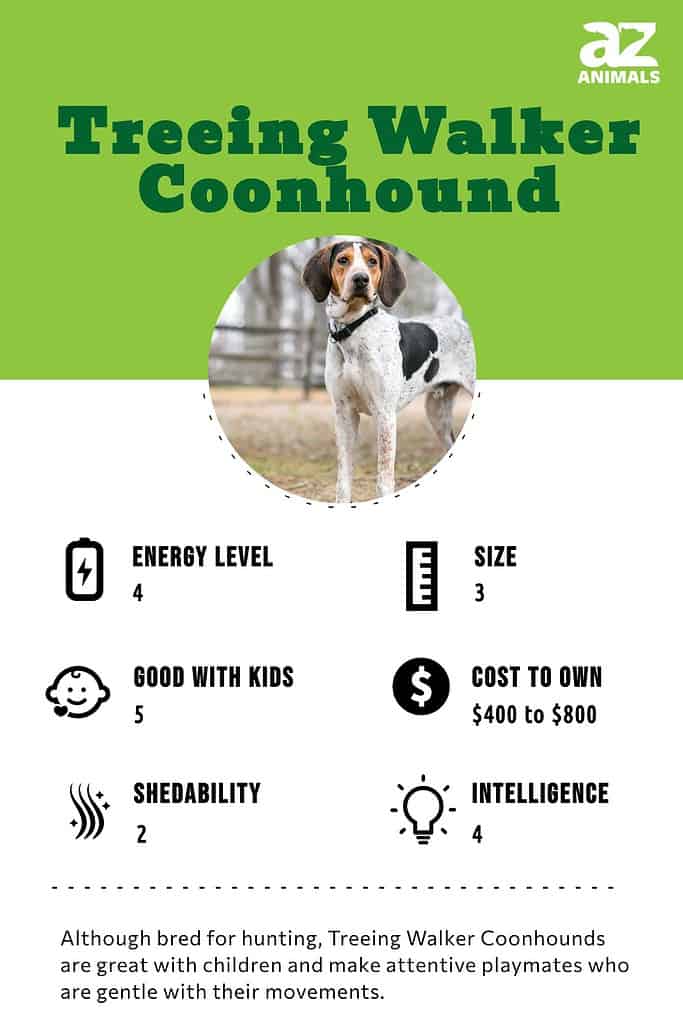
3 Pros and Cons of Owning Treeing Walker Coonhound
| Pros! | Cons! |
|---|---|
| Low-maintenance coat: The Treeing Walker Coonhound doesn’t need much grooming. Low on the shedding scale, all this dog’s coat needs is a once-weekly brushing. | Requires a lot of exercise: These dogs need at least an hour a day of vigorous exercise but the more, the better. Time in the backyard will not be enough and they need to go on walks, hikes, and active play sessions. |
| Excellent hunter: Partly named after a hunting technique and with a lineage tracing to foxhounds, this breed is very skilled at hunting on its own or in a pack. | Will follow his nose: The Treeing Walker Coonhound has a high prey drive and should not be let off the leash when outdoors and not in an enclosed area. |
| Friendly: Walkers are sociable and family-friendly. They make attentive playmates and are surprisingly great with children. | Can be strong-willed: This breed can be independent-minded and stubborn, so early training and socialization is helpful and important. |
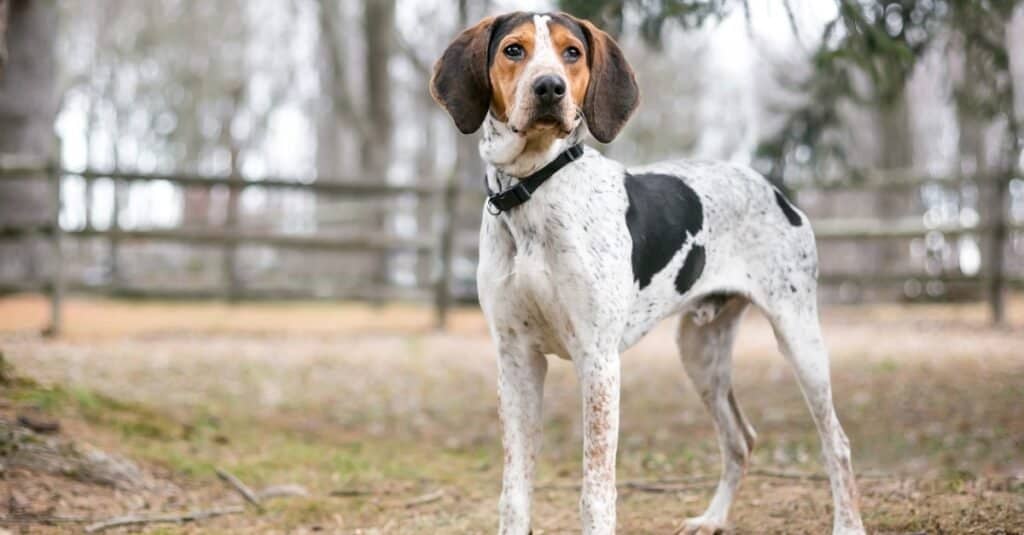
A Treeing Walker Coonhound is an excellent hunting dog.
©Mary Swift/Shutterstock.com
Evolution and Origins
The name of this breed contains a lot of information about its origins. Treeing Walker Coonhounds are named after a hound dog’s “treeing” technique during hunts, in which it tracks prey by its scent until the animal is forced to run up a tree for safety while the dog waits below and barks loudly until the hunter arrives. These dogs also contain the name of a key family in the development of the breed in the 1700s, who imported and bred hounds from England: Walker. Finally, the last part of their name comes from coonhound dogs who were bred to hunt raccoons and larger game.
Originally descended from English and American foxhounds, the Treeing Walker Coonhound is one of the oldest breeds in the U.S. It was developed when a dog called “Tennessee Lead” was crossed with a Walker foxhound in the 1800s. Early on it was classified as an English Coonhound, however, after receiving the name we know it as today, it was recognized as a separate breed by the United Kennel Club in 1945 and by the American Kennel Club in 2012.

This breed is descended from the coonhound, which was originally bred to hunt raccoons.
Health and Entertainment for your Treeing Walker Coonhound
See all of our expert product reviews.
©everydoghasastory/Shutterstock.com
Different Types of Treeing Walker Coonhound Mixes
The most common coloration found is tri-color, a combination of white, black, and tan. Walkers can also be mostly white with patches of black or tan, or mostly black with white or tan areas.
The Treeing Walker Coonhound is commonly cross-bred with other hounds, such as the Bluetick Coonhound, resulting in a Bluetick Walker. Another cross-breed resulted in the Beagle, an excellent hunting dog who is also family-oriented.
Other non-hunting breeds, such as the Boxer, are crossed with Walkers, resulting in the BT Walker. When crossed with a Poodle, the result is a Treeing Walker Coonoodle. A Walker with a Bulldog results in the English Bull-Walker.
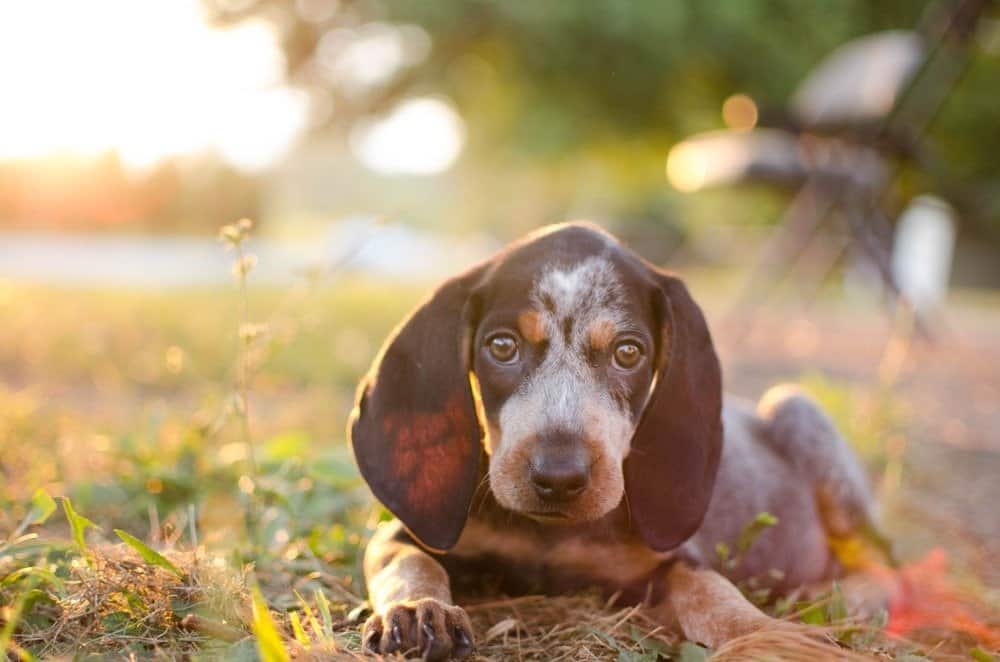
The Bluetick Coonhound is one breed that the Treeing Walker Coonhound is crossed with.
©Kiana Skojec/Shutterstock.com
Size and Weight
The Treeing Walker Coonhound is a medium-sized dog with a sturdy, lean build. He was developed to run effortlessly while pursuing prey and should look the part of an athlete, with weight in proportion to height.
| Height (male) | 27″ tall |
| Height (female) | 25″ tall |
| Weight (male) | 70 lbs, fully grown |
| Weight (female) | 70 lbs, fully grown |
Common Health Issues
The breed is generally healthy, but there are a few issues to be aware of. Like many athletic breeds, Walkers may develop hip dysplasia, one reason why finding a reputable breeder is important. Also, due to their floppy ears, it is easy for moisture and debris to become trapped, leading to ear infections. It is important to check and clean their ears frequently to keep them healthy.
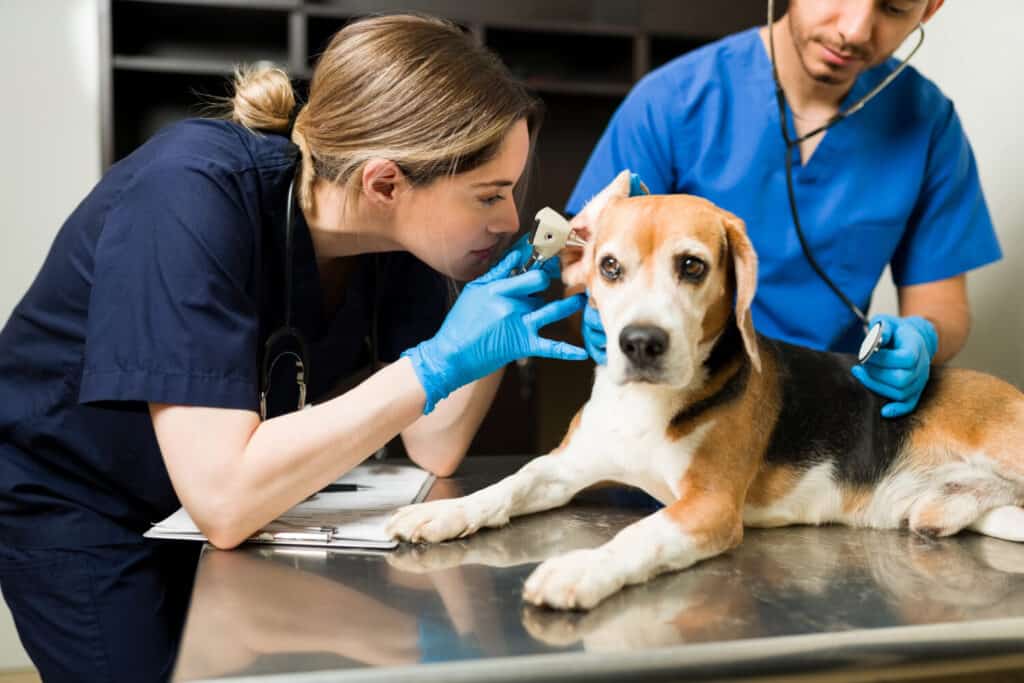
Ear infections can develop if moisture and debris are not cleaned out.
©Beach Creatives/Shutterstock.com
Temperament
Walkers are generally calm, sociable, and loyal. They are typically patient and they enjoy spending time with children. However, when taken for a hunt, Walkers immediately focus and begin casting for scent, using their high energy to become relentless hunters.

A Treeing Walker Coonhound is typically calm, sociable, and patient.
©iStock.com/ExcitingTravelsGoNow
How to Take Care of Treeing Walker Coonhound
Walkers are low-maintenance for the most part, they get enough exercise daily. Their affectionate nature makes these dogs a good choice for families with children and other pets. Unlike many hunting breeds, Walkers can quickly learn to leave the family cat alone.
The Best Dog Food for Treeing Walker Coonhounds
Puppies should be fed a high-quality puppy food three times a day. Once they reach six months, Walkers can transition to around two meals a day. While some people choose to eventually move to one feeding a day, breaking the meal into two servings helps reduce boredom and encourages good eating habits. Once your dog reaches around 1 year of age, you should transition to a high-quality adult dog food.
Treeing Walker Coonhounds are fortunate enough to not get too many health issues, so there are plenty of dog foods that they would likely thrive on. But at A-Z Animals, our Treeing Walker Coonhound dog food choice is Purina ONE SmartBlend Natural Large Breed Formula Adult Dry Dog Food.
This food is made to support the health of large dogs. As such, it has a special hip and joint health formula fortified with glucosamine. There’s plenty of clean protein from chicken to fuel Treeing Walker Coonhounds’ high activity level. Plus, there are fatty acids, vitamins, minerals, and antioxidants for a robust immune system that fights off ear infections easily.
Follow the link below to buy Purina ONE SmartBlend Natural Large Breed Formula on Chewy and Amazon.
- Real chicken recipe for large breeds
- Supports immune system, high energy, and healthy coat
- Formulated with fish oil and glucosamine for joint health
Maintenance and Grooming
The breed is about as low maintenance as it gets when it comes to grooming. Going over his coat with a brush once a week, along with brushing his teeth every other day, is pretty much all you have to do for this breed. Use a cotton ball or gauze square dampened with a veterinary-recommended ear-cleaning solution to wipe out his ears once a week as well. Finally, clip toenails as often as necessary.
While the breed doesn’t require baths often, you may want to wipe off his feet with a damp cloth when bringing him inside during wet weather to avoid any infections and dirt brought into your home. Start doing this from a young age and he will quickly learn to wait at the door and not be bothered by the wiping when he comes inside.

Treeing Walker Coonhounds are actually low-maintenance when it comes to grooming.
©Lindsay Helms/Shutterstock.com
Training
Start working with your pup as soon as you bring him home. Walkers can be strong-willed, so introducing short, positive training sessions early on is important to establish good manners. Since the mature hound can reach 70 pounds and has a high energy level, it is important he knows how to behave.
Don’t mistake his stubbornness for a lack of intelligence. Like many strong-willed breeds, the Treeing Walker Coonhound will shut down if treated poorly. Use patience, positive reinforcement, and rewards and your pup will be more than happy to please you.

Short, positive sessions are beneficial for training Treeing Walker Coonhounds.
©Mike Piers/Shutterstock.com
Exercise
Anyone planning on owning a Walker should love the outdoors. These dogs need a minimum of one hour a day of vigorous exercise but the more, the better. Unfortunately, allowing him in the backyard every now and then will not be enough. Instead, plan on walks, jogs, hikes, obedience training, and active play with toys in the backyard.
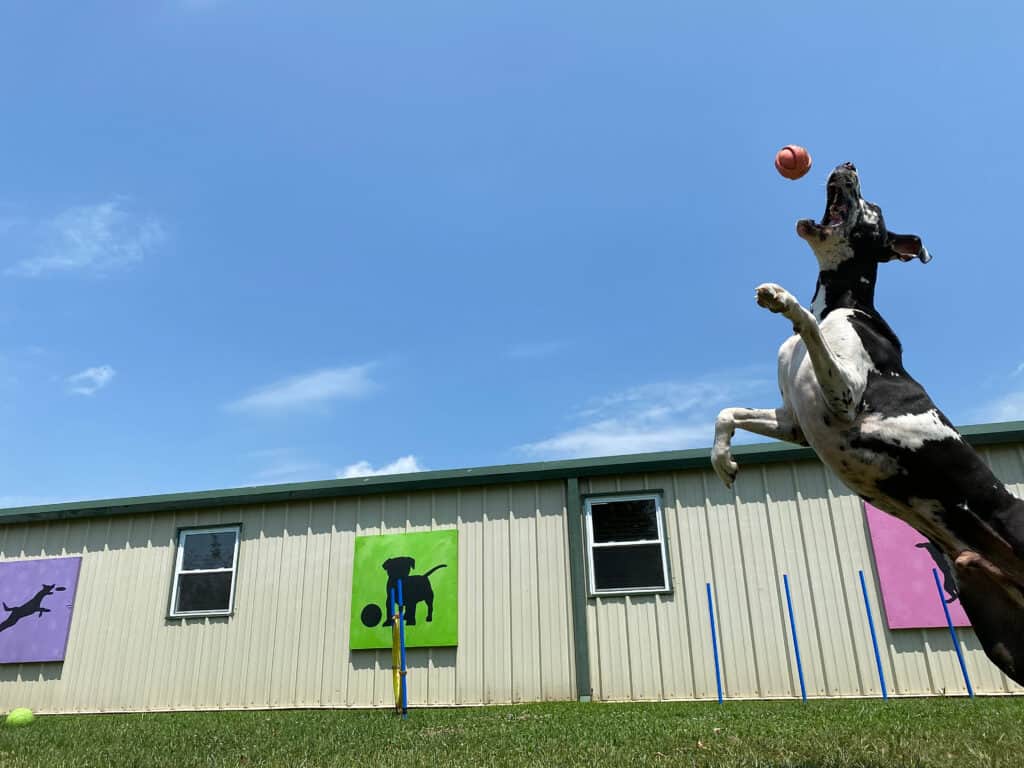
Dogs like this need vigorous outdoor exercise each day.
©Ryan Brix/Shutterstock.com
Puppies
Walkers produce an average of 4 to 6 puppies per litter. When looking for a pup, visit a reputable breeder or adoption agency. Walkers, like many hunting dogs, are frequently available from backyard breeders. Choose a reputable breeder with health certificates verifying proof of vaccination along with any health issues that may present within a litter.
Reputable breeders offer a health guarantee on their pups and spend time analyzing bloodlines to ensure the litter has the preferred temperament, lacks genetic predisposition to diseases, and is overall healthy. If you consider adoption, a reputable agency will let you know why a particular dog was surrendered and work with you to find a good match for you.
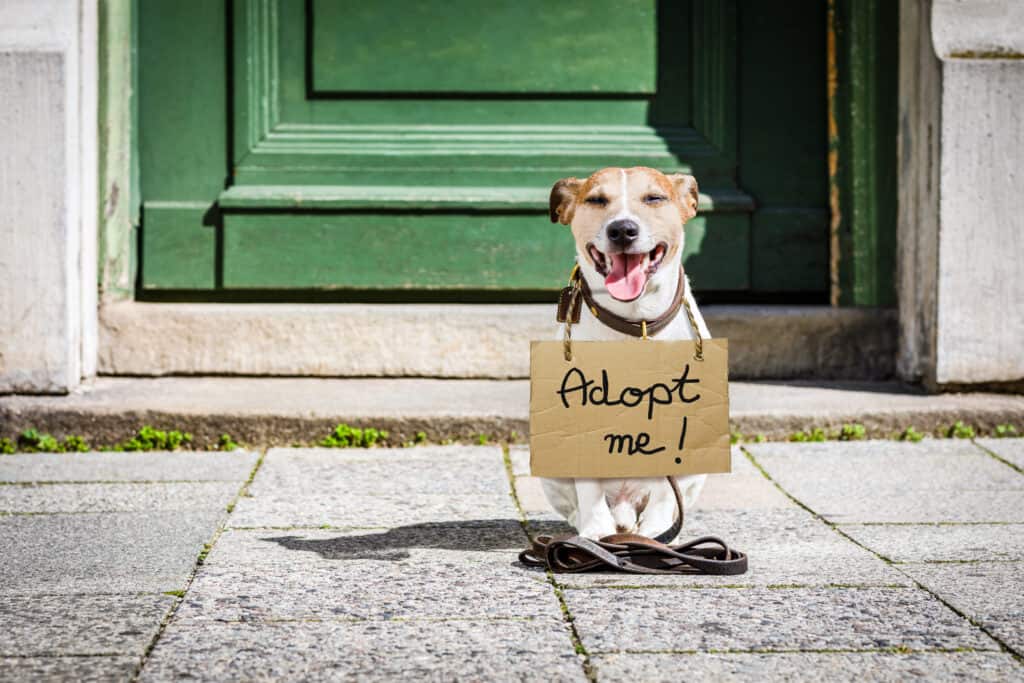
As with all breeds, when looking for a dog, choose a reputable breeder or adoption organization.
©iStock.com/damedeeso
Treeing Walker Coonhound and Children
One of the facts that are often overlooked is how wonderful Treeing Walker Coonhounds are with children. They are attentive playmates, aware of their size, and gentle with their movements. This sociable hound may surprise you with an affinity for playing with children, but always supervise interactions between the dog and young children. As patient as this breed is, their floppy ears can become convenient handles for rough play, and their tolerance may encourage rowdy behavior from youngsters.
Dogs Similar to Treeing Walker Coonhound
If you find the Treeing Walker Coonhound appealing, but want to consider some similar breeds, there are several that may be a good fit.
- American Foxhound – The oldest American dog breed, and an ancestor of the Treeing Walker Coonhound.
- Bloodhound – A loveable and well-mannered choice.
- Beagle – Intelligence and hound personality in a more compact size. The Beagle is a good fit for those who love hounds but want a more manageable-sized dog.

The beagle offers a smaller hound option for those who are fans of the Treeing Walker Coonhound.
©NinaM/Shutterstock.com
Popular Names for Treeing Walker Coonhound
Some popular names for hunting hounds include:
- Ace
- Brutus
- Bear
- Chase
- Moose
Treeing Walker Coonhound FAQs (Frequently Asked Questions)
How much does the Treeing Walker Coonhound cost to own?
The average price of a Treeing Walker Coonhound puppy is between $400 and $800. Budget for annual veterinarian checkups and examinations as well. One of the facts that make this dog a popular choice for many is that it is generally a sturdy, healthy breed.
Is the Treeing Walker Coonhound good with kids?
The breed is a great choice for active families. The good nature and patience this hound offers make him a wonderful companion for kids, while his high energy level gives him the endurance for hiking, jogging, and other adult activities.
As with any breed, it is important to introduce your dog and child carefully and supervise their interactions, but the breed typically makes fast friends with children, both the ones in their family and others they encounter.
How long does the Treeing Walker Coonhound live?
The average lifespan of the dog is between 12 and 13 years. Be prepared for the breed to remain active, as even the oldest dog will hop up with excitement when you grab the leash.
What is a Treeing Walker Coonhound?
The breed was developed by crossing American and English Foxhounds. They are well-suited for hunting alone or in packs. While most often used to hunt racoons, they can also be used on other prey, including bobcats and bears.
The hound hunts by treeing its quarry, holding it up the tree until the hunter can reach it. They are aggressive with their treeing skills, standing on their back legs and stretching upward, preventing their target from escaping.
Do Treeing Walker Coonhounds make good pets?
The breed makes a wonderful choice for active families. As long as they have sufficient activity, they are good-natured, loyal companions. They need at least an hour of outdoor exercise each day, and more is better. Without sufficient exercise, they can become restless, spend time whining and crying, or be destructive.
Do Treeing Walker Coonhound smell?
The breed does have a slightly musty odor. It isn’t the strong “wet dog” smell that you may be accustomed to. Keep the smell in check with occasional baths and by using wet wipes designed for use on pets.
Is Treeing Walker Coonhound affectionate?
The breed is very affectionate. Although they don’t have the natural exuberance of some breeds, they have a very sweet and loving nature. Don’t let their calm demeanor fool you — they are devoted to their family.
Are Treeing Walker Coonhounds hard to train?
The breed is known for strong-willed behavior, but that doesn’t necessarily make it difficult to train. Starting when the pup is young, and using short, positive training sessions, make the breed more receptive to training. The breed is intelligent and can learn quickly as long as you keep the dog’s interest.
How much do Treeing Walker Coonhounds cost?
The average price of the breed is between $400 and $800. If the price seems out of range, consider adoption. One of the facts that cannot be denied is that this breed has a very high energy level. Many households underestimate this, leading to very nice dogs being available for adoption.
Do Treeing Walker Coonhounds make good house dogs?
As long as the dog gets sufficient exercise, they make good house dogs. The breed has a relatively long lifespan and will stay active into old age. They can develop separation anxiety and appreciate living in a household where they don’t spend a great deal of time alone.
How do Treeing Walker Coonhounds signal?
Before they pick up a scent, it is normal for the dog to cast around, sniffing the ground and whining, although some dogs are silent when searching for a scent. When following scent, the hound makes a baying noise. Once the quarry is up in a tree, they switch to a short, choppy bark.
What hairbrush is best for a Treeing Walker Coonhound?
A brush with short, dense bristles will do a good job of keeping the coat clean and free of loose hair.
How big do Treeing Walker Coonhound mixes get?
The size of the mix depends on what breed he is mixed with. Many hounds are roughly the same size as the Treeing Walker Coonhound, so the resulting mix will be similar in size. Mixing with a Beagle, a popular choice, will result in a smaller and more compact dog.
What are the differences between American Foxhounds and Treeing Walker Coonhounds?
The differences between American Foxhounds and Treeing Walker Coonhounds include their hunting behavior, size, and temperament.
Thank you for reading! Have some feedback for us? Contact the AZ Animals editorial team.
Sources
- United Kennel Club, Available here: https://www.ukcdogs.com/treeing-walker-coonhound
- American Kennel Club, Available here: https://www.akc.org/dog-breeds/treeing-walker-coonhound/
- American Kennel Club, Available here: https://www.akc.org/expert-advice/lifestyle/treeing-walker-coonhound/

